Energy Evolution Pattern and Roof Control Strategy in Non-Pillar Mining Method of Goaf-Side Entry Retaining by Roof Cutting—A Case Study
Abstract
:1. Introduction
2. Case Study
2.1. Numerical Model
2.2. Parameter Verification and Analysis of Abutment Pressure
3. Results of Numerical Simulation
3.1. Strata Movement
3.2. Energy Density Evolution of Surrounding Rock
4. Proposed Supporting Strategy
4.1. Supporting Measure
- (1).
- In the GERRC progress and the second goaf-side entry retaining progress, the roof of roadway is affected by the in-situ stress and disturbed stress. The high constant resistance and large deformation (CRLD) anchor cable has a huge advantage in resistant to dynamic loading. Therefore, the high CRLD anchor cable is selected to control the deformation and damage of surrounding rock.
- (2).
- The stress state and mechanical property of surrounding rock could be improved by the increasing pretension of bolting. It contributes to keep the stability of the roadway roof.
- (3).
- The numerical simulation result shows that intense stress disturbance region of surrounding rock is in front of the working face 17 m and behind working face 55 m in GERRC. In the second goaf-side entry retaining, the range is in front of the working face 45 m. Improving roadway supporting (hydraulic support) is used to control the surrounding rock deformation in stress disturbance region.
4.2. Reinforcement System for Roadway
- (1)
- When the roadway excavation, the roof of the roadway is supported by withthread steel cable, CRLD anchor cable and mesh. The thread steel cable is 20 mm in diameter and 1.1 m in length, and the inter-row space is set to 0.86 m 1 m. Furthermore, three CRLD anchor cables (= 21.6 mm, = 7300 mm) were set in the roadway roof, which the inter-row space is set to 1.72 m 1 m and 0.99 m 1 m. The pre-tightening force of the CRLD anchor cable is set to 200 KN. This step could contribute to improve the strength of the rock mass and prevent collapse of the roadway roof. The CRLD anchor cable also contributed to restrict dynamic load.
- (2)
- In the progress of GERRC, the combined support with thread steel cable, CRLD anchor cable, mesh, and the hydraulic prop (rated working resistance, 294 KN. initial work resistance: 114–154 KN. maximum support height: 2.24 m. minimum support height: 1.44 m, column travel: 0.8 m) were installed in disturbed stress zone, which is located in front of working face 17 m and behind working face 60 m.
- (3)
- In the second goaf-side entry retaining, the hydraulic prop is installed in front of working face 45 m.
5. Monitoring Results
5.1. The Subsidence Displacement of Roof
5.2. Axial Force of the CRLD Anchor Cable
6. Conclusions
Author Contributions
Funding
Conflicts of Interest
References
- Wang, Y.; Gao, Y.; Wang, E.; He, M.; Yang, J. Roof Deformation Characteristics and Preventive Techniques Using a Novel Non-Pillar Mining Method of Gob-Side Entry Retaining by Roof Cutting. Energies 2018, 11, 627. [Google Scholar] [CrossRef]
- He, M.C.; Zhu, G.L.; Guo, Z.B. Longwall mining “cutting cantilever beam theory” and 110 mining method in China—The third mining science innovation. J. Rock Mech. Geotech. Eng. 2015, 7, 483–492. [Google Scholar] [CrossRef] [Green Version]
- Zhang, G.F.; Man-Chao, H.E.; Xue-Ping, Y.U.; Zheng-gu, H. Research on the Technique of No-Pillar Mining with Gob-Side Entry Formed by Advanced Roof Caving in the Protective Seam in Baijiao Coal Mine. J. Min. Saf. Eng. 2011, 28, 511–516. [Google Scholar]
- Sun, X.; Liu, X.; Liang, G.; Wang, D.; Jiang, Y.L. Key parameters of gob-side entry retaining formed by roof cut and pressure releasing in thin coal seams. Chin. J. Rock Mech. Eng. 2014, 33, 1449–1456. [Google Scholar]
- Guo, Z.; Wang, J.; Cao, T.; Chen, L.; Wang, J. Research on key parameters of gob-side entry retaining automatically formed by roof cutting and pressure release in thin coal seam mining. J. China Univ. Min. Technol. 2016, 45, 879–885. [Google Scholar]
- Zhang, G.; Xu, Y.; Ge, P. Research on cut gob-side entry retaining in thin coal seam of Tangshan ditch. Chin. J. Rock Mech. Eng. 2016, 35, 1397–1406. [Google Scholar]
- Cai, F.; Miao, P.; Wang, E.; Wang, J. Fracture condition and moving rule of surrounding rocks in the joint cutting immediate roof of thick-layer limestone. Caikuang Yu Anquan Gongcheng Xuebao. J. Min. Saf. Eng. 2017, 34, 488–494. [Google Scholar]
- Manchao, H.E.; Gao, Y.; Yang, J.; Guo, Z.; Wang, E.; Wang, Y. An energy-gathered roof cutting technique in no-pillar mining and its impact on stress variation in surrounding rocks. Chin. J. Rock Mech. Eng. 2017, 36, 1314–1325. [Google Scholar]
- Xue, J.H.; Han, C.L. Strata Behavior and Control Countermeasures for the Gob-Side Entry Retaining in the Condition of Large Mining Height. J. Min. Saf. Eng. 2012, 29, 466–473. [Google Scholar]
- Chen, Y.; Bai, J.B.; Wang, X.Y.; Ma, S.Q.; Xu, Y.; Bi, T.F.; Yang, H.Q. Support technology research and application inside roadway of gob side entry retaining. J. China Coal Soc. 2012, 37, 903–910. [Google Scholar]
- Kang, H.; Niu, D.; Zhen, Z.; Lin, J.; Li, Z. Deformation characteristics of surrounding rock and supporting technology of gob-side entry retaining in deep coal mine. Chin. J. Rock Mech. Eng. 2010, 29, 1977–1987. [Google Scholar]
- Zhang, N.; Han, C.L.; Han, J.G.; Zhang, X.G. Theory and practice of surrounding rock control for pillarless gob-side entry retaining. J. China Coal Soc. 2014, 39, 1635–1641. [Google Scholar]
- Gao, Y.; Liu, D.; Zhang, X.; He, M. Analysis and Optimization of Entry Stability in Underground Longwall Mining. Sustainability 2017, 9, 2079. [Google Scholar] [CrossRef] [Green Version]
- He, M.; Cao, W.; Shan, R.; Wang, S. Blasting technology—Bilateral cumulative tensile explosion. Chin. J. Rock Mech. Eng. 2003, 22, 2047–2051. [Google Scholar]
- Gao, F.; Stead, D. Discrete element modelling of cutter roof failure in coal mine roadways. Int. J. Coal Geol. 2013, 116, 158–171. [Google Scholar] [CrossRef]
- Cundall, P.A. Adaptive density-scaling for time-explicit calculations. In Proceedings of the 4th International Conference on Numerical Methods in Geomechanics (Edmonton 1982), Edmonton, AB, Canada, 31 May–4 June 1982. [Google Scholar]
- Itasca Consulting Group, Inc. 3DEC User Manual; Itasca Consulting Group, Inc.: Minneapolis, MN, USA, 2016. [Google Scholar]
- Bai, J.B.; Shen, W.L.; Guo, G.L.; Wang, X.Y.; Yu, Y. Roof Deformation, Failure Characteristics, and Preventive Techniques of Gob-Side Entry Driving Heading Adjacent to the Advancing Working Face. Rock Mech. Rock Eng. 2015, 48, 2447–2458. [Google Scholar] [CrossRef]
- Yang, W.; Lin, B.Q.; Qu, Y.A.; Li, Z.W.; Zhai, C.; Jia, L.L.; Zhao, W.Q. Stress evolution with time and space during mining of a coal seam. Int. J. Rock Mech. Min. Sci. 2011, 48, 1145–1152. [Google Scholar] [CrossRef]
- Xu, Z. Mechanics of Elasticity, 4th ed.; Higher Education Press: Beijing, China, 2006. [Google Scholar]
- Sun, X.L.; Liu, J.B.; Zhu, H. Correlational fractal characterisation of stress and acoustic emision during coal and rock failure under multilevel dynamic loading. Int. J. Rock Mech. Min. Sci. 2019, 117, 1–10. [Google Scholar] [CrossRef]
- Maleki, H.N.; Weaver, A.; Acre, R. Stress-Induced Stability Problems—A Coal Mine Case Study. In Proceedings of the 32nd US Symposium on Rock Mechanics (USRMS), Norman, OK, USA, 10–12 July 1991. [Google Scholar]
- Mahdevari, S.; Shahriar, K.; Sharifzadeh, M.; Tannant, D.D. Stability prediction of gate roadways in longwall mining using artificial neural networks. Neural Comput. Appl. 2017, 28, 3537–3555. [Google Scholar] [CrossRef]
- Shi, X.M.; Liu, B.G.; Tannant, D.; Qi, Y. Influence of consolidation settlement on the stability of inclined TBM tunnels in a coal mine. Tunnell. Undergr. Space Technol. 2017, 69, 64–71. [Google Scholar] [CrossRef]
- Du, W.; Jiang, Y.; Ma, Z.; Jiao, Z. Assessment of water inrush and factor sensitivity analysis in an amalgamated coal mine in China. Arab. J. Geosci. 2017, 10, 471. [Google Scholar] [CrossRef]
- He, J.; Dou, L.; Gong, S.; Li, J.; Ma, Z. Rock burst assessment and prediction by dynamic and static stress analysis based on micro-seismic monitoring. Int. J. Rock Mech. Min. Sci. 2017, 93, 46–53. [Google Scholar] [CrossRef]
- He, M.; Guo, Z. Mechanical property and engineering application of anchor bolt with constant resistance and large deformation. Chin. J. Rock Mech. Eng. 2014, 33, 1297–1308. [Google Scholar]
- He, M.; Gong, W.; Wang, J.; Qi, P.; Tao, Z.; Du, S.; Peng, Y. Development of a novel energy-absorbing bolt with extraordinarily large elongation and constant resistance. Int. J. Rock Mech. Min. Sci. 2014, 67, 29–42. [Google Scholar] [CrossRef]

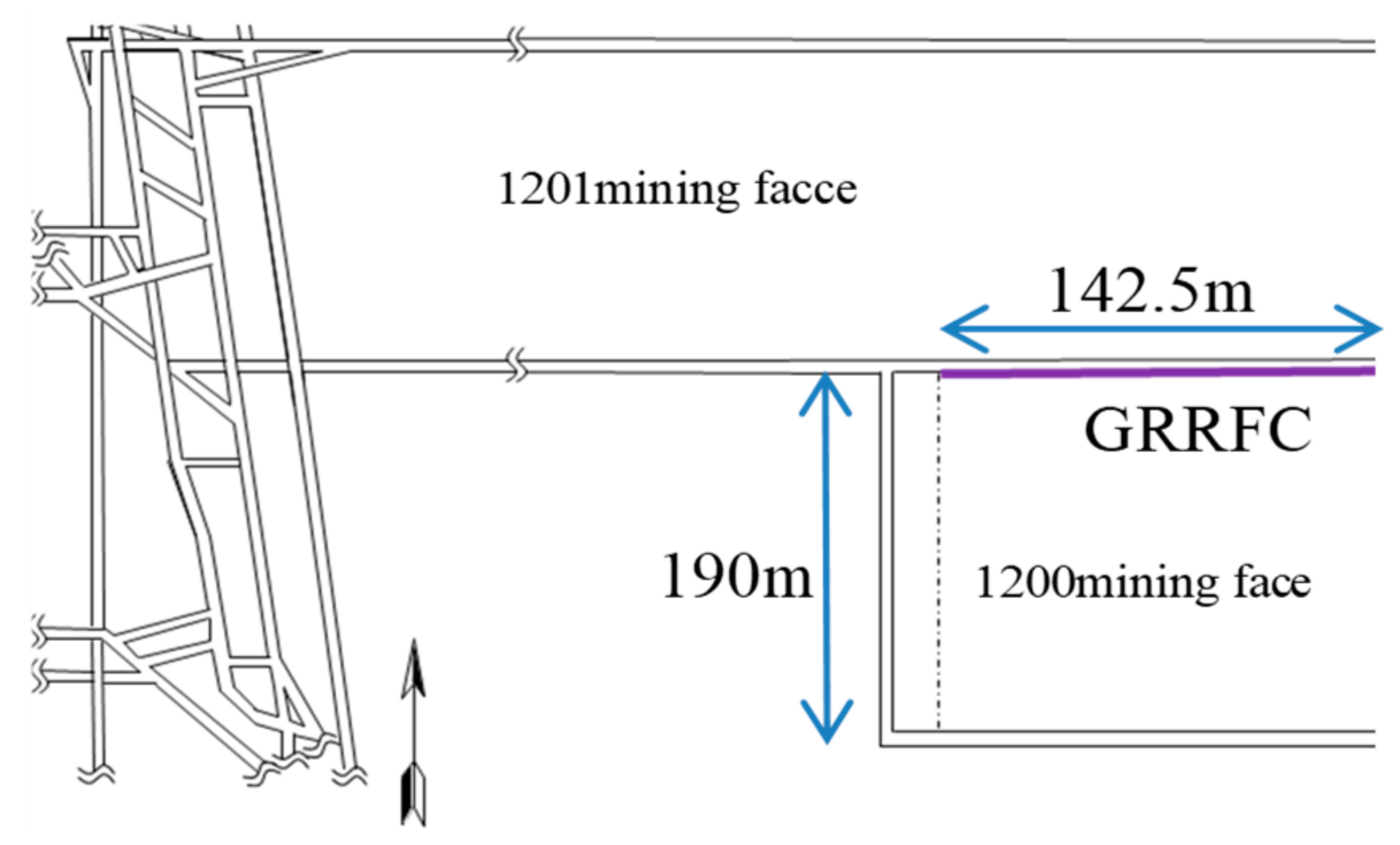
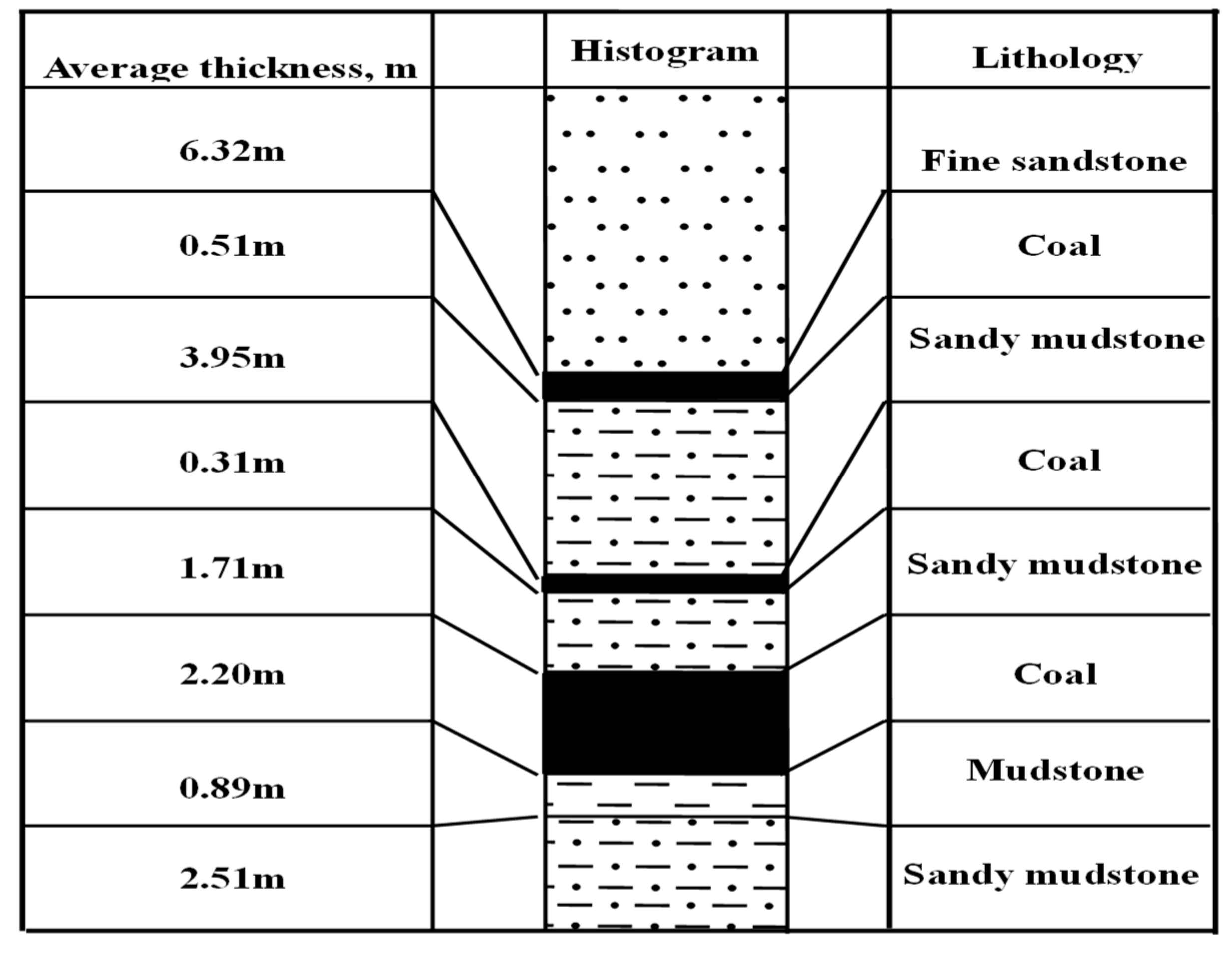
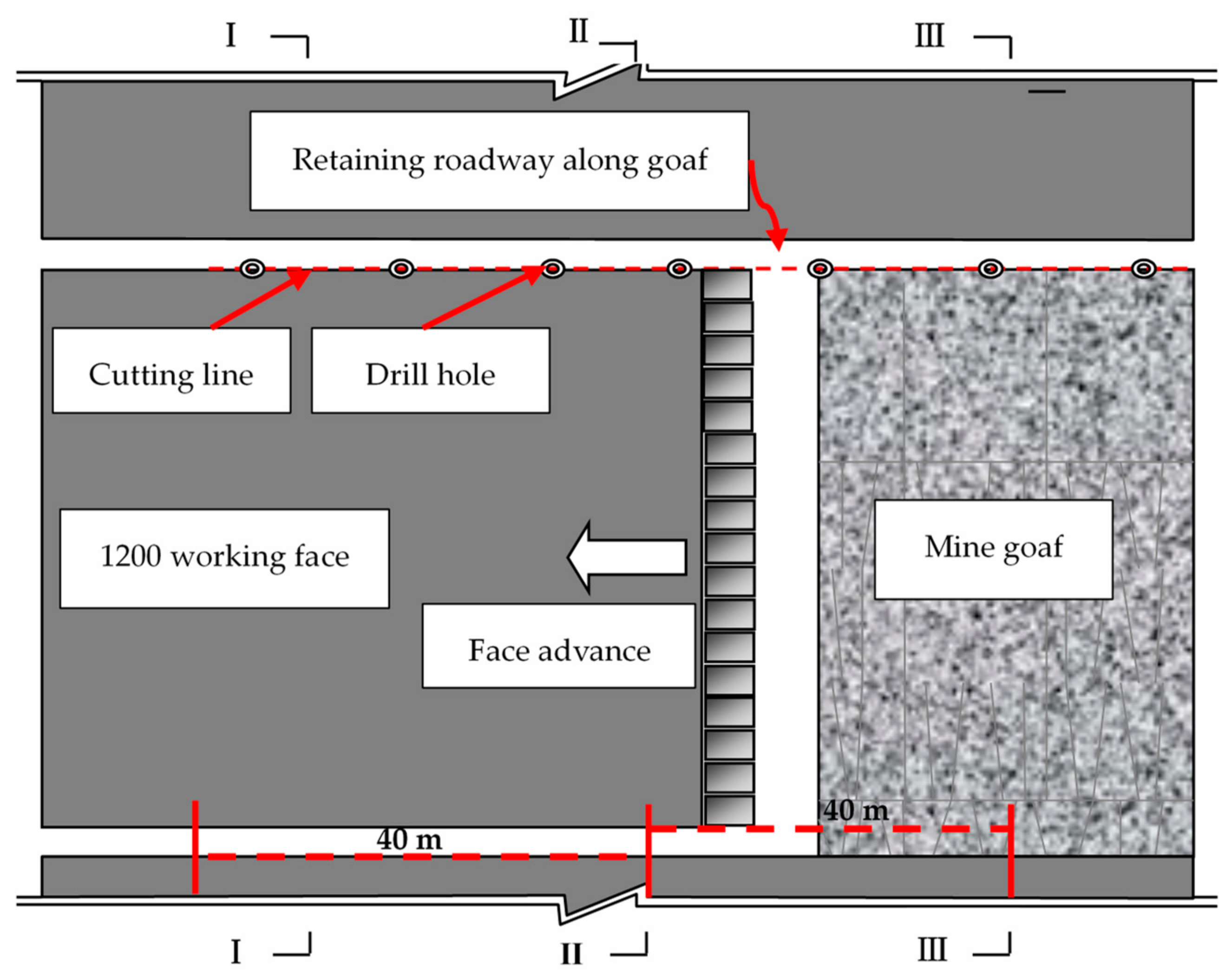

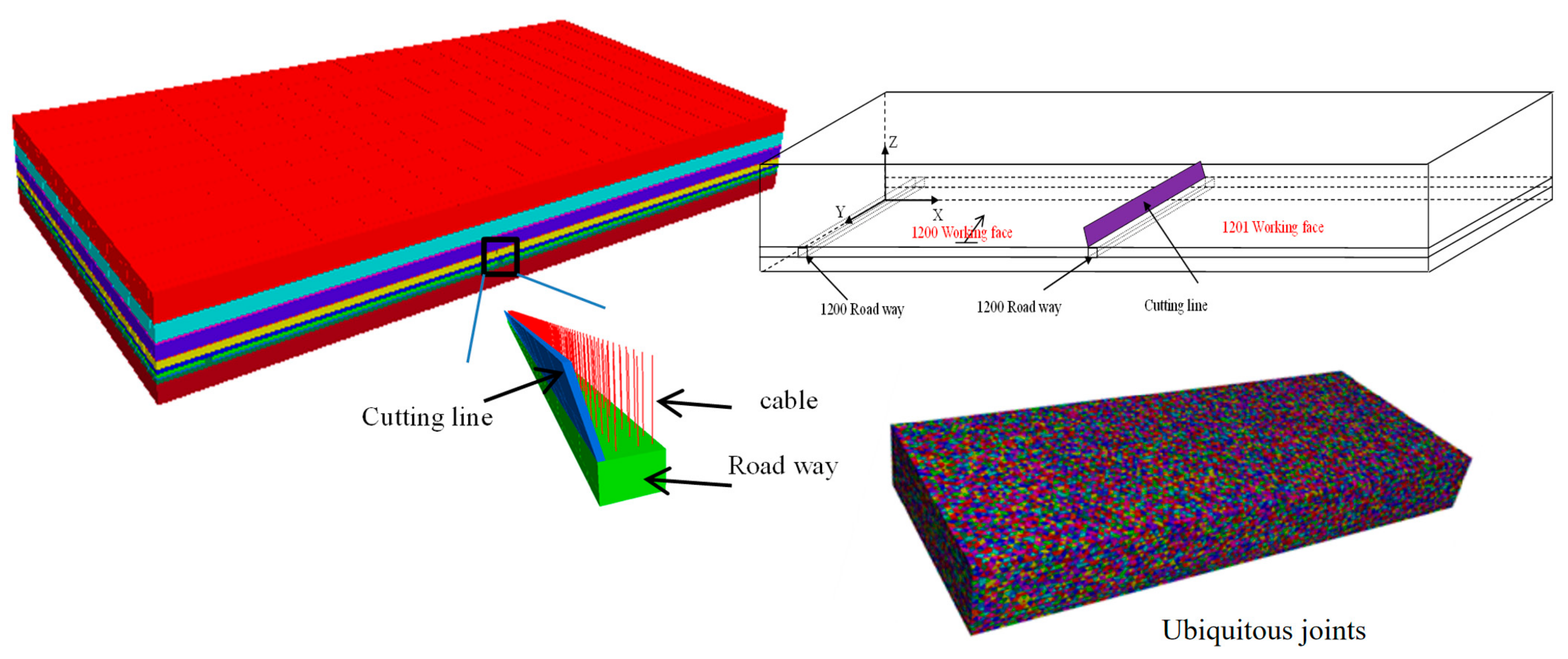






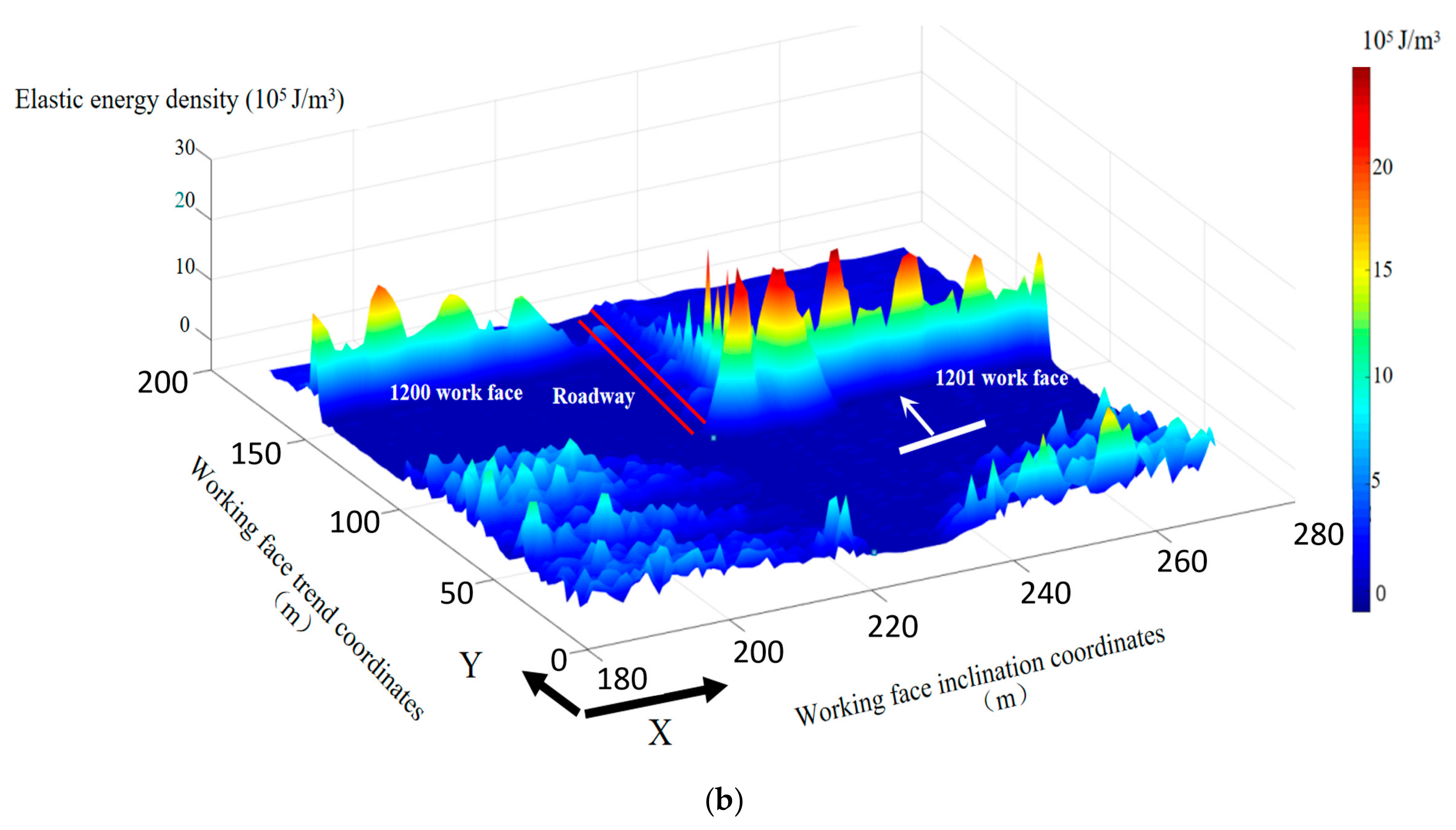
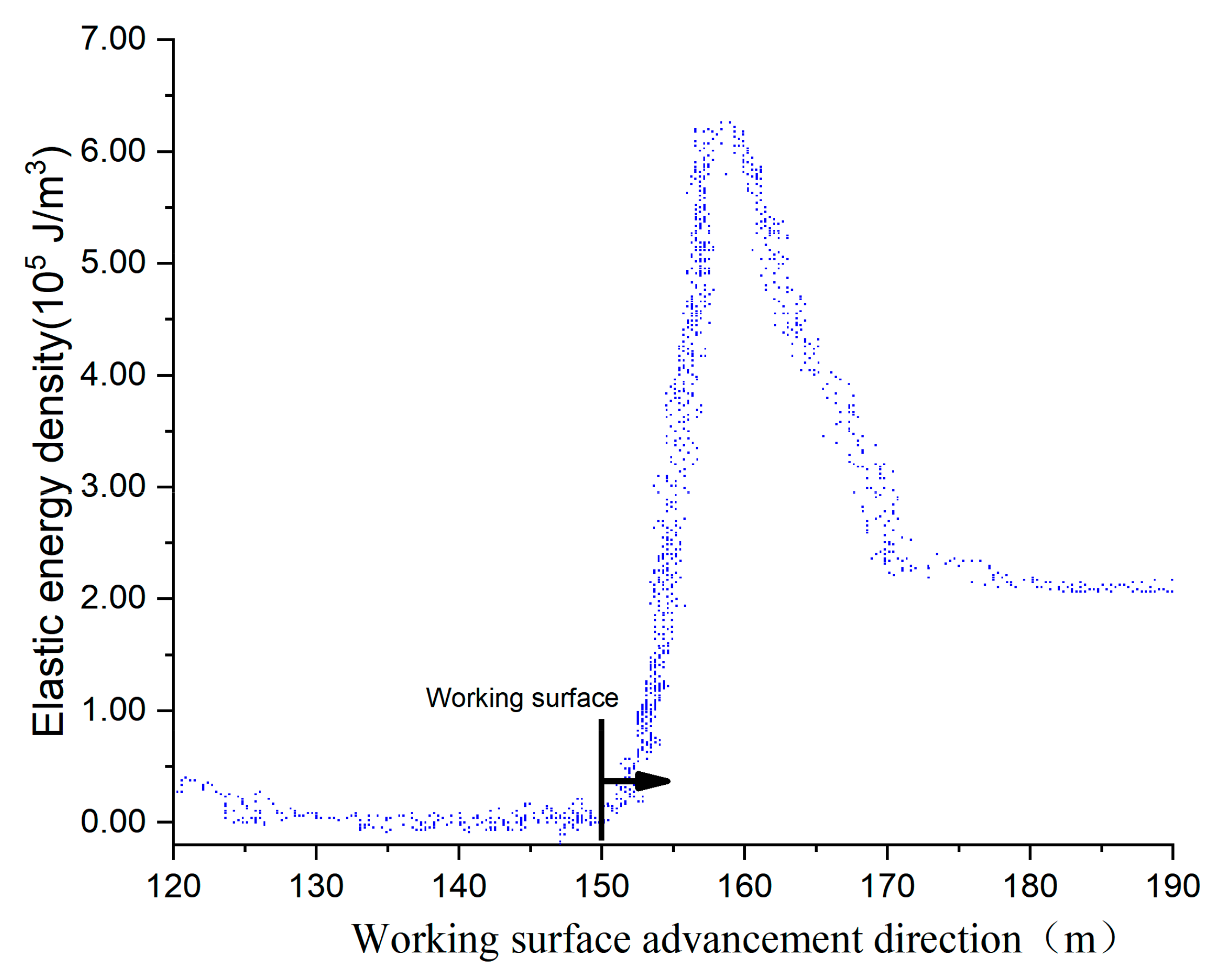
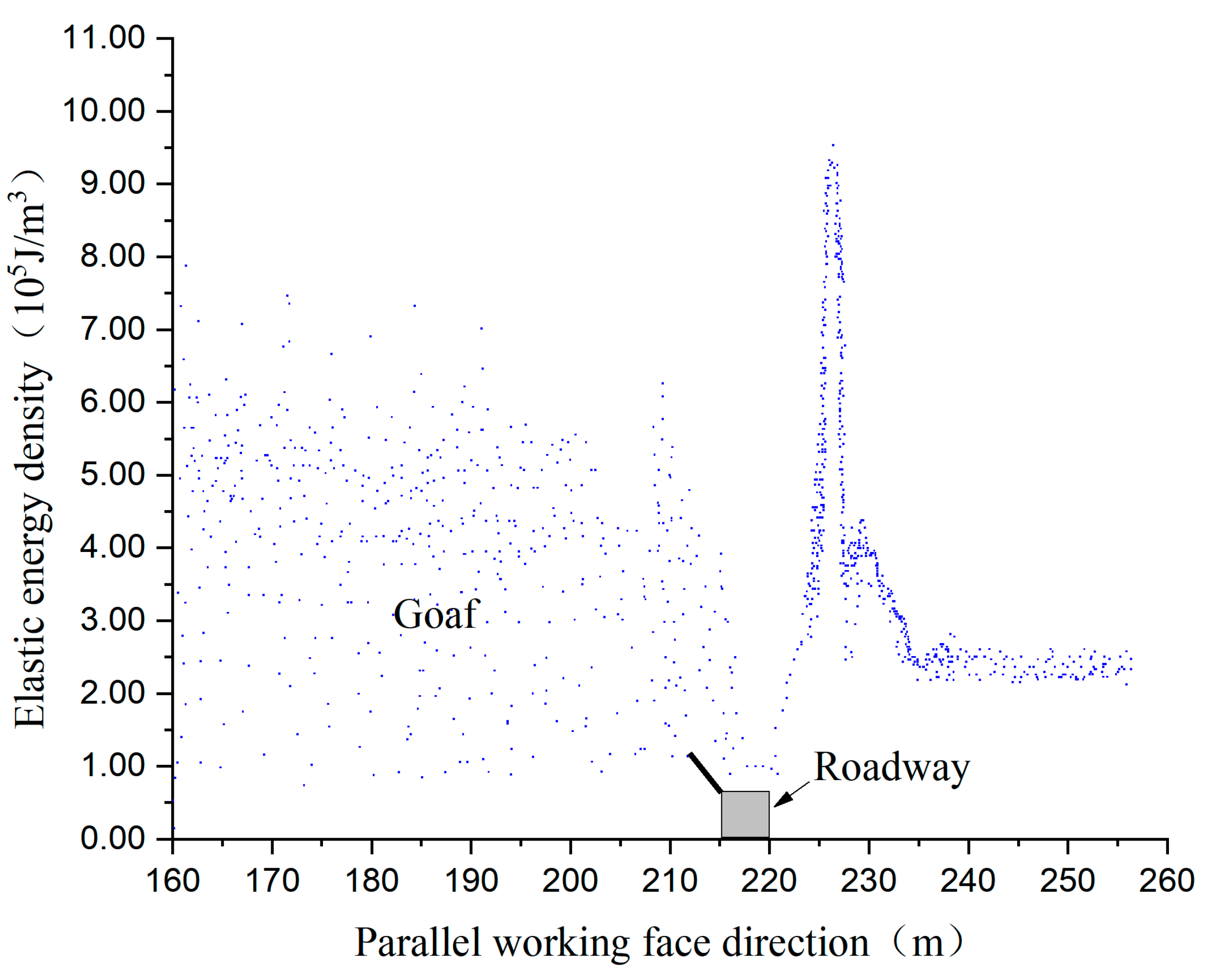
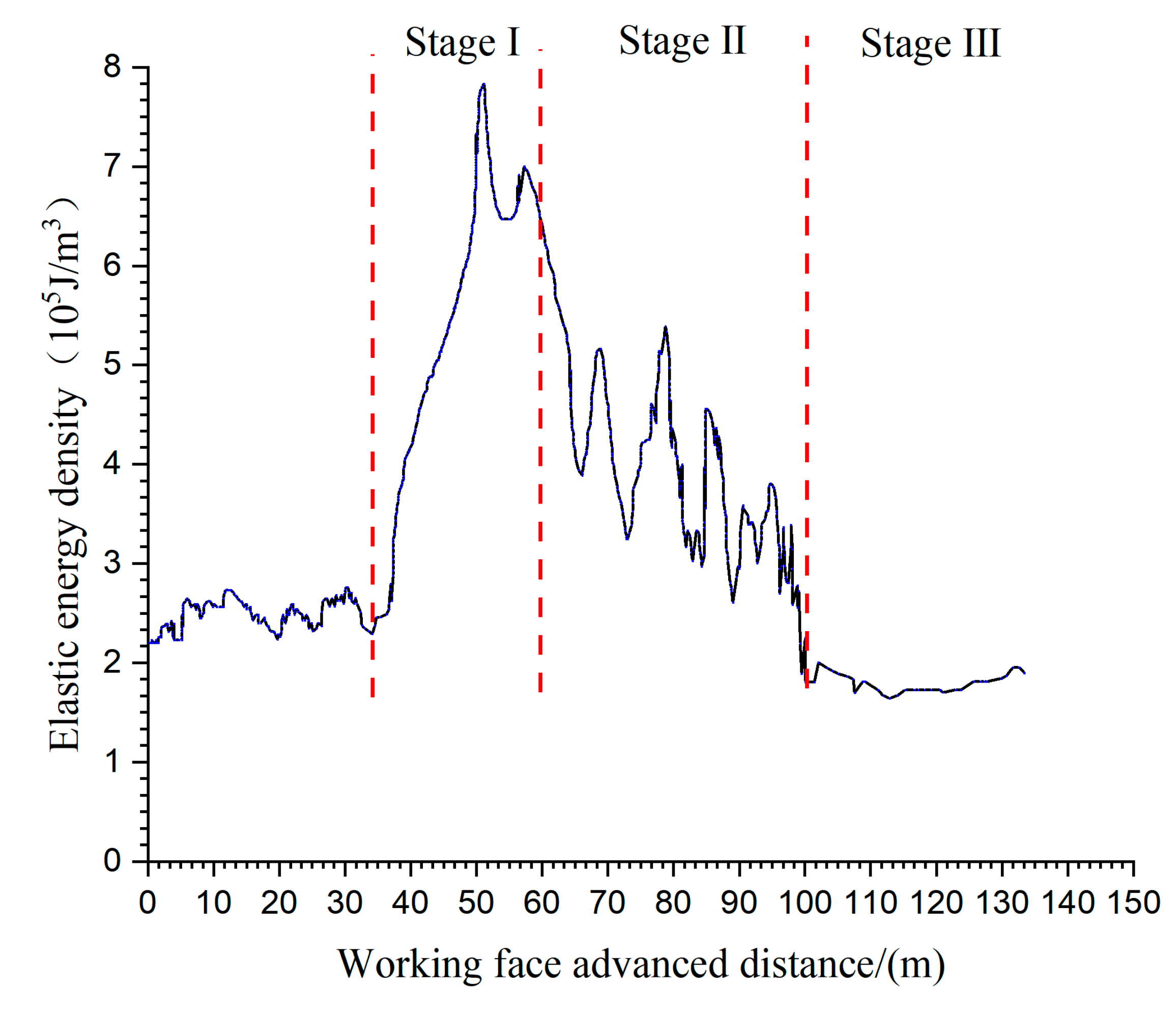
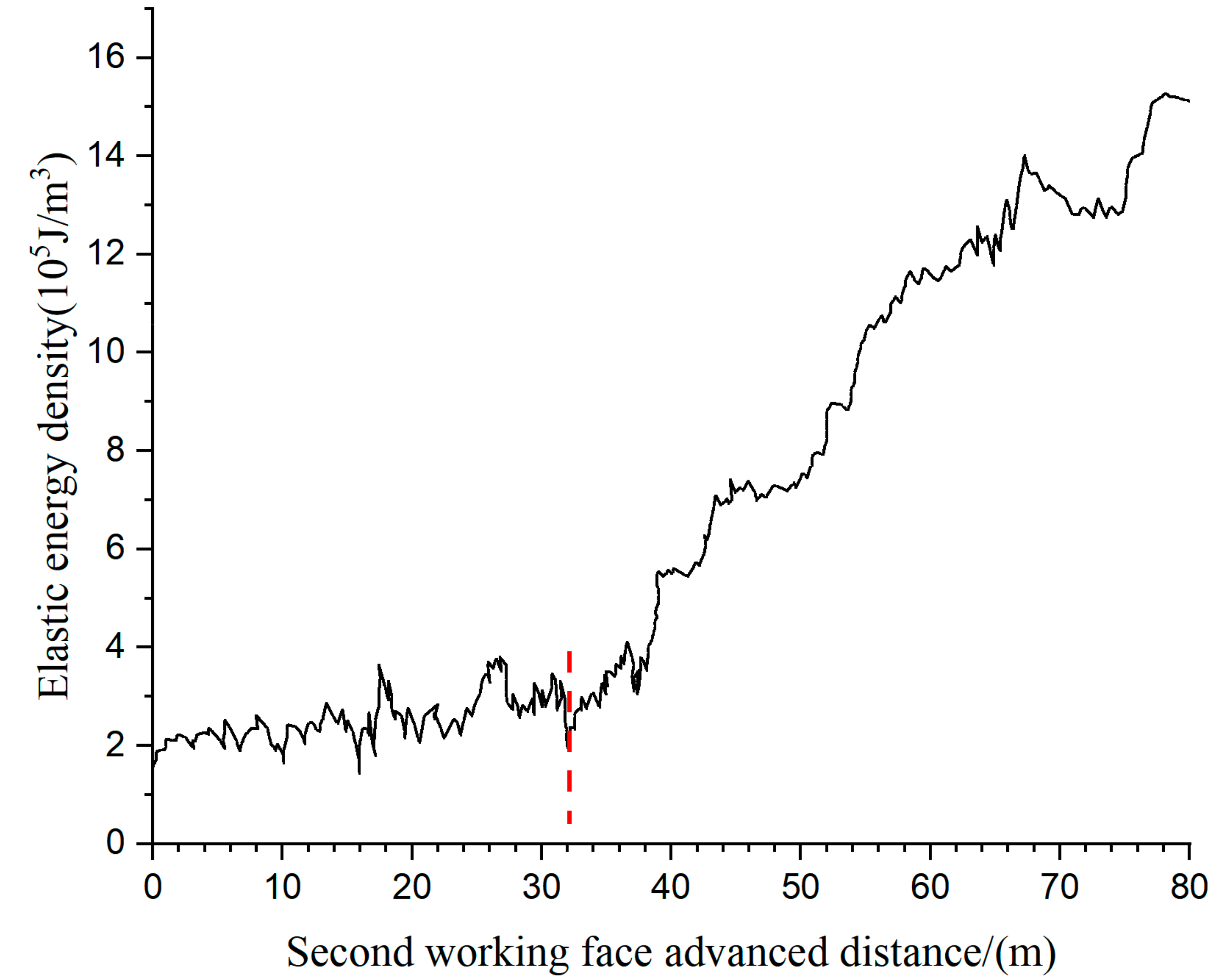


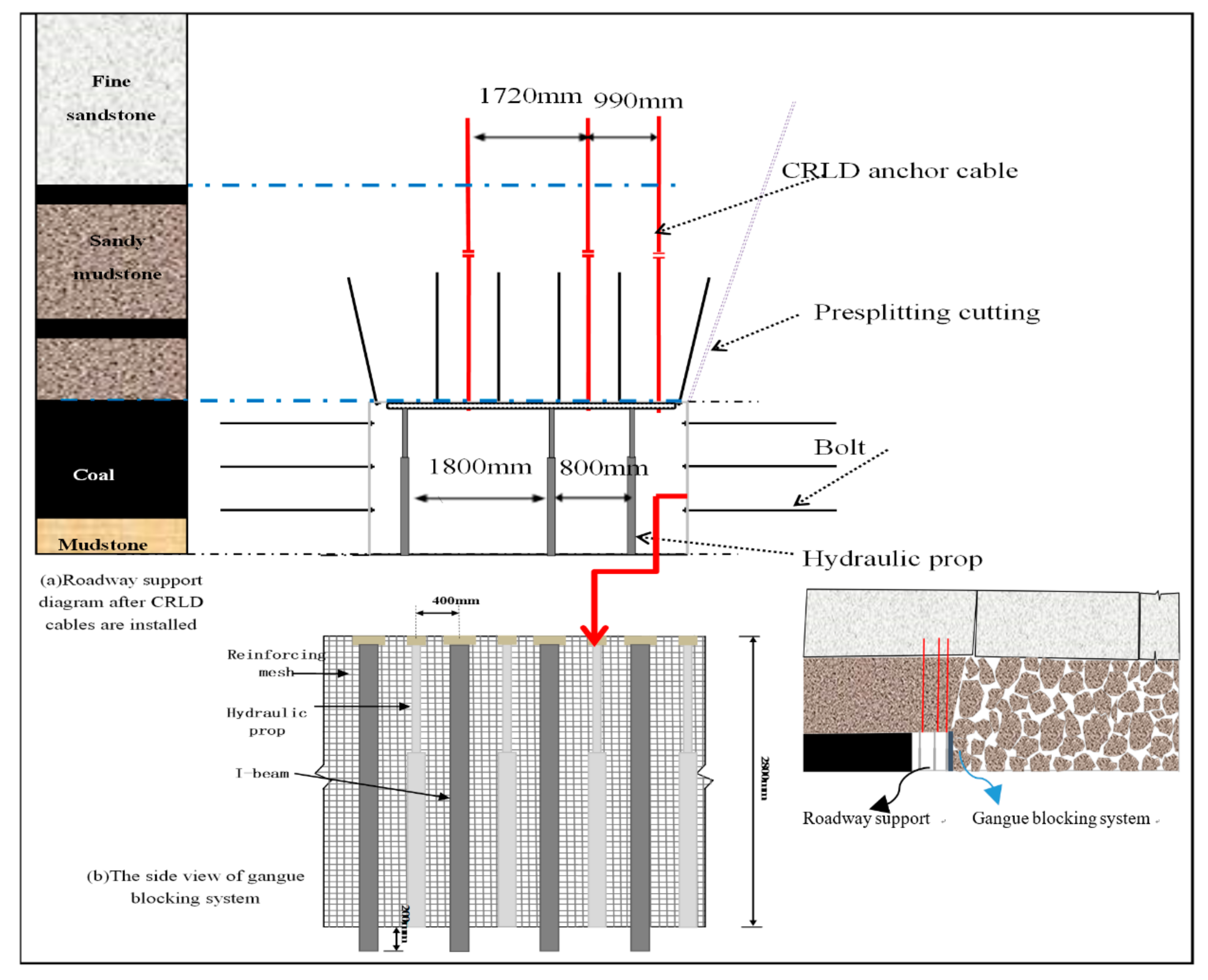


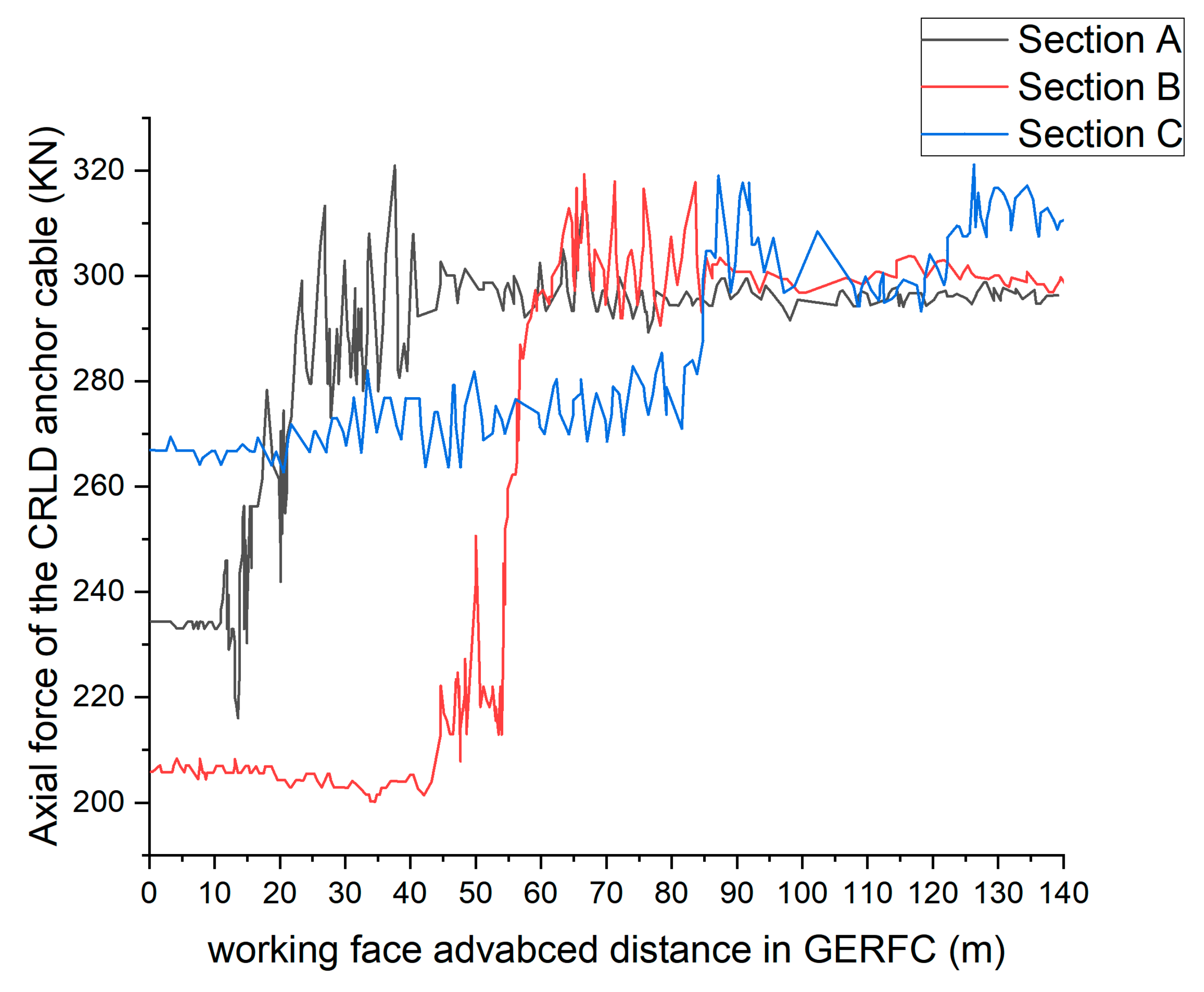
| Lithology | Thickness (m) | Density (kg/m3) | Bulk Modulus (GPa) | Shear Modulus (GPa) | Cohesion (MPa) | Internal Friction Angle )_ | Tensile Strength (MPa) |
|---|---|---|---|---|---|---|---|
| sandy mudstone | 15 | 2350 | 10.76 | 5.7 | 1.18 | 35 | 1.17 |
| fine sandstone | 9.0 | 2350 | 18.02 | 14.02 | 3.8 | 43 | 5.13 |
| sandy mudstone | 1.0 | 2400 | 4.9 | 3.2 | 1.18 | 35 | 1.80 |
| fine sandstone | 6.5 | 2755 | 16.04 | 12.02 | 3.47 | 43 | 5.00 |
| coal | 0.5 | 1435 | 0.85 | 0.38 | 1 | 28 | 0.50 |
| sandy mudstone | 4.0 | 2400 | 5.12 | 4.73 | 2.45 | 40 | 2.01 |
| coal | 0.3 | 1435 | 0.63 | 0.145 | 0.34 | 30 | 0.20 |
| sandy mudstone | 1.8 | 2400 | 4.9 | 3.2 | 1.18 | 35 | 1.80 |
| coal | 2.2 | 1435 | 0.46 | 0.19 | 0.8 | 20 | 0.20 |
| mudstone | 1.0 | 2350 | 1.72 | 1.45 | 1.8 | 40.7 | 3.36 |
| sandy mudstone | 2.2 | 2400 | 10.76 | 5.7 | 1.18 | 35 | 1.17 |
| Lithology | Normal Stiffness (GPa·m−1) | Tangential Stiffness (GPa·m−1) | Cohesive Force (MPa) | Internal Friction Angle |
|---|---|---|---|---|
| sandy mudstone | 9.5 | 6.4 | 4.8 | 28 |
| fine sandstone | 16 | 9.5 | 7.8 | 36 |
| sandy mudstone | 9.5 | 6.4 | 4.8 | 28 |
| fine sandstone | 16 | 9.5 | 7.8 | 36 |
| coal | 6 | 4.7 | 2.8 | 20 |
| sandy mudstone | 9.5 | 6.4 | 4.8 | 28 |
| coal | 6 | 4.7 | 2.8 | 20 |
| sandy mudstone | 9.5 | 6.4 | 4.8 | 28 |
| coal | 6 | 4.7 | 2.8 | 20 |
| mudstone | 8.9 | 5.9 | 4.9 | 27 |
| sandy mudstone | 9.5 | 6.4 | 4.8 | 28 |
© 2019 by the authors. Licensee MDPI, Basel, Switzerland. This article is an open access article distributed under the terms and conditions of the Creative Commons Attribution (CC BY) license (http://creativecommons.org/licenses/by/4.0/).
Share and Cite
Li, L.; Li, G.; Gong, W.; Wang, J.; Deng, H. Energy Evolution Pattern and Roof Control Strategy in Non-Pillar Mining Method of Goaf-Side Entry Retaining by Roof Cutting—A Case Study. Sustainability 2019, 11, 7029. https://doi.org/10.3390/su11247029
Li L, Li G, Gong W, Wang J, Deng H. Energy Evolution Pattern and Roof Control Strategy in Non-Pillar Mining Method of Goaf-Side Entry Retaining by Roof Cutting—A Case Study. Sustainability. 2019; 11(24):7029. https://doi.org/10.3390/su11247029
Chicago/Turabian StyleLi, Lifeng, Gan Li, Weili Gong, Jiong Wang, and Huilin Deng. 2019. "Energy Evolution Pattern and Roof Control Strategy in Non-Pillar Mining Method of Goaf-Side Entry Retaining by Roof Cutting—A Case Study" Sustainability 11, no. 24: 7029. https://doi.org/10.3390/su11247029




